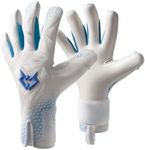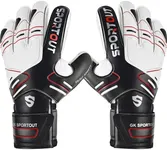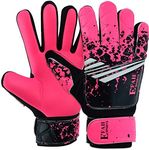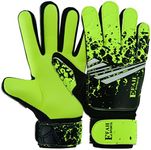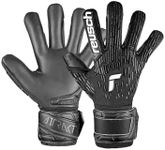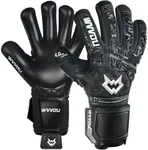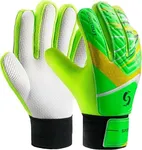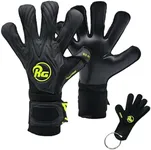Buying Guide for the Best Goalkeeper Gloves
Choosing the right goalkeeper gloves is crucial for any goalkeeper, whether you're playing at a professional level or just for fun. The right gloves can improve your grip, protect your hands, and enhance your overall performance. When selecting goalkeeper gloves, it's important to consider several key specifications to ensure you get the best fit for your needs.GripGrip refers to the ability of the gloves to hold onto the ball. This is important because a good grip can prevent the ball from slipping out of your hands during play. Grip quality is often determined by the type of latex used on the palm. High-end gloves usually have a softer latex that provides excellent grip but may wear out faster, making them ideal for match play. Mid-range gloves offer a balance between grip and durability, suitable for both training and matches. Entry-level gloves have a more durable latex that lasts longer but may not provide the same level of grip, making them good for training or casual play. Choose the grip quality based on how often you play and the level of performance you need.
CutThe cut of the gloves refers to the way the glove is stitched and how it fits your hand. This is important because the cut affects comfort, flexibility, and control. There are several types of cuts: flat cut, roll finger, negative cut, and hybrid cuts. Flat cut gloves have a looser fit and are generally more comfortable, making them suitable for beginners. Roll finger gloves provide a snug fit and more latex contact with the ball, offering better grip and control, ideal for advanced players. Negative cut gloves have internal stitching for a tighter fit, providing excellent control and a more natural feel, preferred by professional goalkeepers. Hybrid cuts combine elements of different cuts to offer a balance of comfort and performance. Choose the cut based on your comfort preference and level of play.
SizeSize is crucial for ensuring the gloves fit properly and provide the best performance. Gloves that are too big can slip off, while gloves that are too small can be uncomfortable and restrict movement. To find the right size, measure the circumference of your hand just below the knuckles, excluding the thumb. Most brands provide a size chart to help you match your measurement to the correct glove size. It's important to try on different sizes if possible, as fit can vary between brands. Choose a size that offers a snug fit without being too tight, allowing for comfortable movement and optimal control.
Finger ProtectionFinger protection refers to the technology used in gloves to prevent finger injuries. This is important for goalkeepers who want to reduce the risk of hyperextension or other finger injuries. Finger protection systems usually involve spines or inserts that provide extra support to the fingers. Some gloves have removable spines, allowing you to customize the level of protection. Gloves with finger protection are ideal for younger players or those prone to finger injuries. If you prefer more flexibility and a natural feel, you might opt for gloves without finger protection. Choose based on your need for injury prevention versus flexibility.
DurabilityDurability refers to how long the gloves will last under regular use. This is important because durable gloves can save you money in the long run and ensure consistent performance. Durability is often influenced by the type of latex and the overall construction of the gloves. High-end gloves with softer latex may offer excellent grip but wear out faster, making them less durable. Mid-range gloves offer a balance of grip and durability, suitable for regular use. Entry-level gloves are usually more durable but may not provide the same level of grip, making them ideal for training. Choose based on how often you play and whether you prioritize grip or longevity.
Weather ConditionsWeather conditions can affect the performance of your gloves, so it's important to consider this when choosing a pair. Some gloves are designed specifically for wet conditions, with latex that provides better grip when wet. Others are made for dry conditions, offering optimal performance in sunny weather. All-weather gloves aim to provide a balance, performing reasonably well in both wet and dry conditions. If you play in varying weather conditions, all-weather gloves might be the best choice. If you mostly play in specific conditions, choose gloves designed for those conditions to ensure the best performance.
